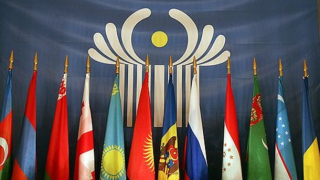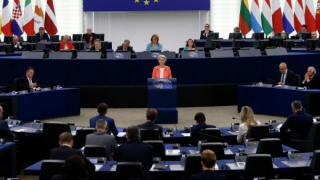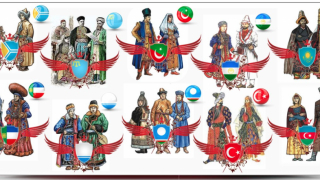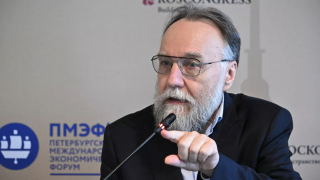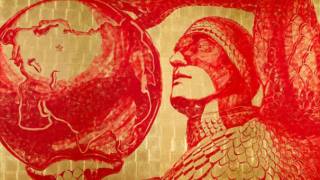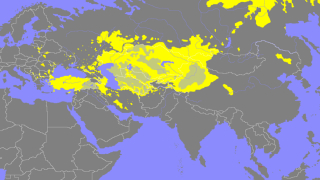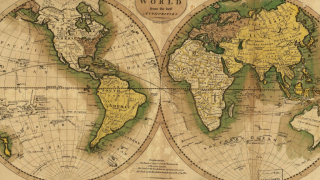On Pan-Turanism
Turan was the name given to Central Asia by the Iranian peoples in ancient times. Pan-Turanism aims to unite all Turkic and other Altaic peoples in one political and/or cultural unit under the name Turan. This covers a vast area stretching from Turkey through the Caucasus, northwestern Iran and Central Asia to the Arctic Ocean. For some Pan-Turanists, this also includes former Ottoman Southeastern Europe and Crimea, which clearly points to irredentism.
Origin of Pan-Turanism
This ideology emerged in the Fin-de-Siècle among Ottoman nationalist officers and intelligentsia. They wanted to unite all Turkic peoples in a political entity stretching from the Bosphorus to the Altai Mountains. From around 1911, the term 'Turan' was used to include all Turkic peoples – including those outside historical Turan (i.e. Central Asia).
During World War I, the Ottoman nationalist elite promoted Pan-Turanism among the Turkic peoples of Tsarist Russia to incite them to revolt and annex the Caucasus and Central Asia.
After the First World War and the subsequent Turkish War of Independence, Mustafa Kemal Atatürk founded the Republic of Turkey. He encouraged Pan-Turanism to replace the existing Ottoman-Islamic identity of the population with a Turkish-secular identity. From then on, it was no longer religion (Sunni Islam), but the nation that had to ensure unity.
Ban on Pan-Turanism in the USSR
The Turkic peoples comprised approximately 10% of the population in the early USSR, making them the second largest ethnic group after the Slavic peoples. They inhabited the 'soft underbelly' of the USSR, i.e. the vulnerable Caucasian and Central Asian regions with rich oil resources, including in the Azerbaijani region of Baku and the Kazakh region of Emba.
The October Revolution stirred up nationalism and separatism among the Turkic (and other non-Russian) peoples in the USSR. The revolution transformed the centralized Russian Empire into a federal state and also led to the creation of a series of ethnically based Soviet republics and autonomous regions. The successful Kemalist republic of Turkey, which had just emerged from the moribund Ottoman Empire, acted as a magnet for the Turkic peoples in the USSR. Turkey also showed a strong mutual interest in the 'brother peoples' in the USSR.
It should therefore come as no surprise that the 10th Congress of the Communist Party of the USSR in 1921 condemned Pan-Turanism as “a tendency towards bourgeois-democratic nationalism”. Because of the threat that Pan-Turanism posed to the USSR, Soviet propaganda made it a fearsome political label. Pan-Turanism was the most common accusation in the harsh repression of the elites of the Turkic peoples in the USSR in the 1930s.
German attempt to balkanize the USSR using Pan-Turanism
During World War II, Turkey remained officially neutral, as previous wars had caused significant territorial losses and enormous suffering. Ideologically however, there were strong similarities between German National Socialism and Turkish Kemalism. Furthermore, Germany had been Turkey's most important trading partner during the 1930s. On June 18, 1941 – 4 days before the start of Operation Barbarossa – Germany and Turkey signed a non-aggression pact.
Operation Barbarossa was a German attempt to destroy Russia. This large-scale invasion of the USSR aimed at eliminating the USSR as a competing superpower, annexing some areas and colonizing other areas, partly expelling and partly subjugating the population, as well as supplying agricultural products and raw materials to Germany.
Although Turkey itself never participated in the war, it initially worked closely with Germany. Turkey provided information and sold large quantities of chrome to Germany. Turkey also provided a Pan-Turan propaganda plan, which served Germany very well in the occupied parts of the USSR. With this, Germany recruited so-called 'Osttruppen' from Soviet prisoners of war, originating from the Turkic peoples in the USSR, for the Wehrmacht (approx. 250,000 men) and for the Waffen-SS (approx. 8,000 men). In return, Germany promised to make areas inhabited by Turkic peoples in the USSR independent. These Turkic states would become part of Turkey's sphere of influence. It is therefore no exaggeration to say that Turkey was a 'neutral Axis country' during the (first half of the) Second World War.
However, due to these good relations between Germany and Turkey, the existing good understanding between Turkey and the USSR, which dated from the Turkish War of Independence, disappeared. The then newly created USSR supplied large quantities of weapons and financed the Kemalist troops of Mustafa Kemal Atatürk.
In the summer of 1942, as the German army advanced towards Stalingrad and the Caucasus, Turkey considered war with the USSR almost inevitable. In February 1942, the Soviets had committed a failed attack on the German ambassador to Turkey and also sunk the Romanian ship SS Struma in Turkish territorial waters. The Turkish army positioned hundreds of thousands of soldiers on its eastern border with the aim of conquering the South Caucasus – and in particular the rich oil fields of Baku.
1944: Pan-Turanism banned in Turkey
After the Allied conquest/reconquest of entire North Africa in November 1942-May 1943 and of Southern Russia in February 1943, good relations developed between Turkey and the liberal Allies (USA and Great Britain). Turkey received financial and military assistance from them. At the Second Cairo Conference in December 1943, American President Roosevelt, British Prime Minister Churchill and Turkish President Inönü discussed Turkish participation in the war on the Allied side. Pan-Turanism was banned by Inönü in the spring of 1944. Its supporters ended up in prison. In August 1944, when the Allied invasion of the Balkans began and German defeat was inevitable, Turkey broke off all relations with Germany.
On February 23, 1945, Turkey finally declared war on Germany (and Japan), because the Yalta Conference (February 4-11, 1945) stipulated that only countries that were officially at war with Germany and Japan on March 1, 1945 would be admitted to the United Nations in formation. So it was purely a symbolic act. Turkish troops never participated in the war.
The war ended with the complete destruction of Germany and the capture of Berlin by the Red Army. On October 24, 1945, Turkey signed the Charter of the United Nations as one of the 51 founding states.
Post-USSR
The implosion of the USSR in 1991 created new opportunities for Pan-Turanism. The Soviet republics of Kazakhstan, Uzbekistan, Kyrgyzstan, Turkmenistan and Azerbaijan, inhabited by Turkic peoples, became independent. The Russian republics of Tatarstan, Bashkiria, Chuvashia, Yakutia, Khakassia and Tuva, also inhabited by Turkic peoples, remained part of Russia.
Pan-Turanists promoted the – mainly cultural – unification of the various Turkic states. On July 12, 1993, Turkey, the new Turkic states and several Russian republics formed the International Organization of Turkic Culture. This is an organization for cultural cooperation. On October 3, 2009, Turkey, Kazakhstan, Uzbekistan, Kyrgyzstan and Azerbaijan founded the Organization of Turkic States. This is a consultative body between Turkic-speaking states.
In contemporary Turkey, Pan-Turanism is an important part of the ideology of the Nationalist Movement Party (MHP), whose youth movement is known as the Gray Wolves. The latter organization is named after a gray she-wolf – named Asena – who, in the pre-Islamic origin myth of the Turkic and Altaic peoples, led the endangered proto-Turkic tribes out of the Siberian and Central Asian wilderness. Asena is used as a symbol by the Gray Wolves.
Pan-Turanism as a threat to Russia, China and Iran
Although Pan-Turanism does not explicitly aim at the disintegration of Russia, in fact, in the case of a political unification of all Turkic territories it largely leads to this. After all, a significant part of the minorities in Russia are Turkic. Naturally, Russia opposes Pan-Turanism. If the Turkic ex-Soviet republics and the Russian constituent republics inhabited by Turkic peoples were to unite with Turkey, this would be at the expense of Russia and the Russian sphere of influence. Traditionally, Russia has been the most important trading partner of these areas: all transport infrastructure connects these areas with Russia. In addition, Pan-Turanism also claims the strategically important Crimea for Russia – formerly inhabited by Crimean Tatars – and other Russian territories.
China and Iran also oppose Pan-Turanism. After all, the Chinese province of Xinjiang – which Pan-Turanists call East Turkistan – is inhabited by Turkic minorities, namely Uygurs, Kazakhs, Kyrgyz, Uzbeks and Tatars. Approximately 18% of the population of Iran belongs to Turkic minorities, mainly Azerbaijanis, Qashqai and Turkmen.


